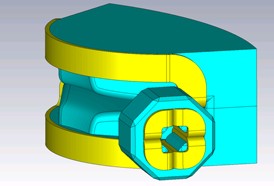AGFA - Argonne Gas Filled Analyzer
AGFA, the Argonne Gas-filled Fragment Analyzer is a state-of-the art gas-filled separator at ATLAS, which is being developed in collaboration among the Argonne Physics Division, Hebrew University, Jerusalem, University of Massachusetts, Lowell, University of Maryland, University of Edinburgh, Lawrence Berkeley National Laboratory and Oregon State University. This separator will be used for a wide range of studies, e.g. 1) in conjunction with Gammasphere for in-beam and calorimetric studies of trans-fermium nuclei, 2) in the stand-alone mode for studies of super-heavy nuclei, isomers in heavy elements, and fast proton and alpha emitters along the proton drip-line, including heavy nuclei, 3) together with a gas catcher to prepare beams of exotic radioactive ions for mass measurements and laser spectroscopy of trapped atoms, and 4) to study, via deep-inelastic reactions, heavy neutron-rich nuclei that are important in the r-process.
The design represents a novel approach to the problem by combining in a single magnetic element, Dm, the required bending capabilities of a dipole with the horizontal focusing and higher order magnetic field components to correct for aberrations and achieve a narrow distribution of the reaction products on the focal plane. Vertical focusing is achieved by a single quadrupole located upstream of the main magnet. This QvDm design (see Fig.1) achieves larger solid angle acceptance than most current separators, yet it has a smaller image size and path length, which leads to higher efficiency for (a) collection of evaporation residues and (b) detection of their decay gamma-rays.
|
Figure 1: Computer-aided design rendering of the magnets of the AGFA separator showing the single quadrupole (front) and the dipole/multipole main magnet (back) including coils in yellow.
|
The project received DOE approval in July 2013 and will be constructed over a 2 1/2 year period with the commissioning taking place in the 1st quarter in 2016. The separator will be installed at the 33o beam line in Area IV – the old APEX beam line. As the physics program envisioned for AGFA includes Recoil-Decay Tagging of prompt gamma-rays emitted from the target, the separator is designed such that Gammasphere can be placed in the target position as illustrated in Fig. 2. In this mode, the distance from the target to the quadrupole is ~80 cm resulting in a solid angle of 22.5 msr. Without the need for prompt gamma-detection, the target chamber can be moved closer, 40 cm upstream of the quadrupole giving a solid angle of >40 msr. The implantation station at the focal plane will be shared with the FMA and includes a large double-sided Si strip detector, probably with 160 strips on each side, housed in a chamber that can be surrounded with five large volume HPGe clover detectors such as those comprising the X-array. Signals from these detectors will be recorded using the digital readout system developed for the FMA. |

Figure 2: Floor plan of ATLAS Area IV shoving the FMA, AGFA and Gammasphere in front of either instrument. |
For more information on this project contact Birger Back.
![[Argonne Logo]](/images/argonne_header_logo.jpg)
![[DOE Logo]](/images/header_doe.gif)
